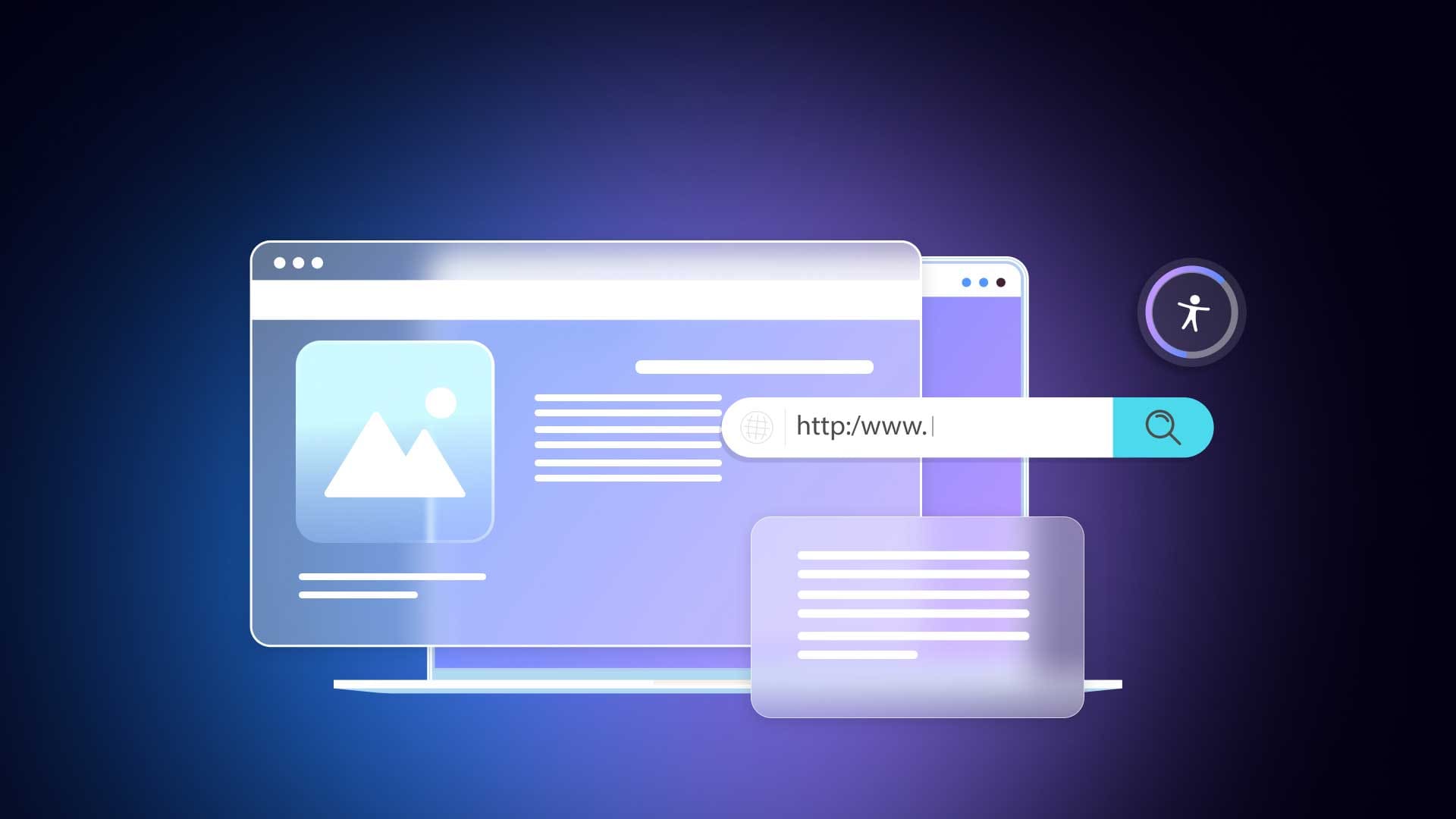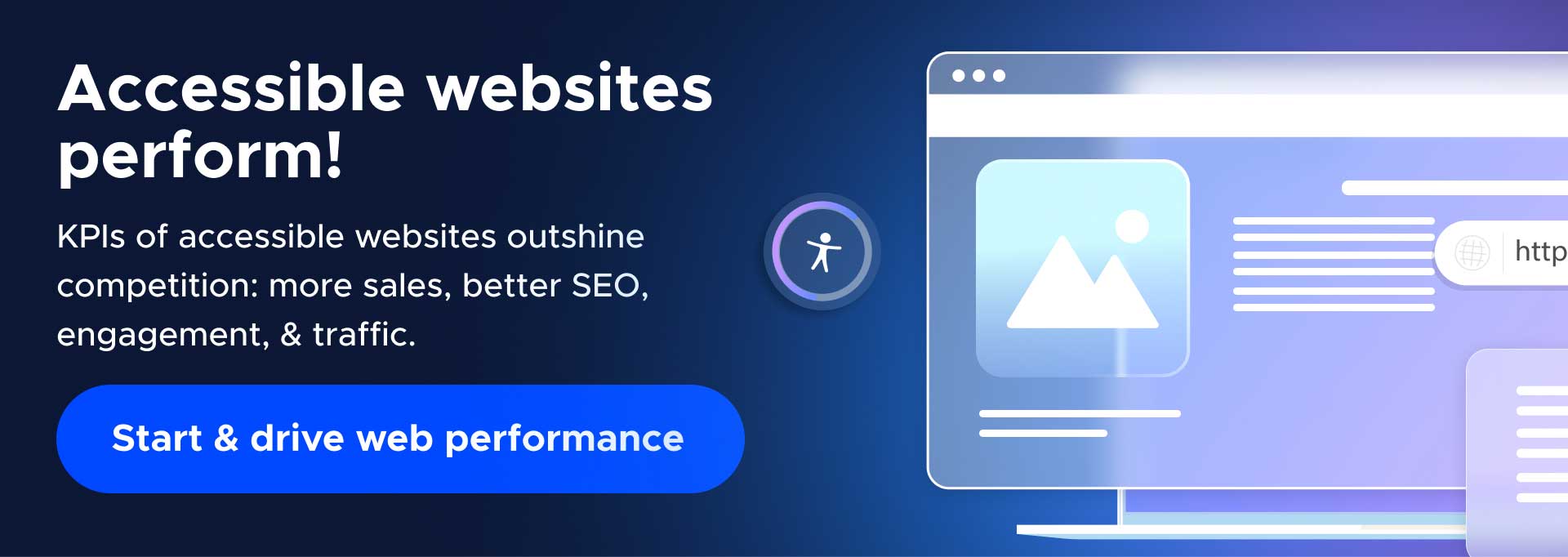Web accessibility & website performance

Businesses globally are becoming more accountable for creating accessible online content and measuring website performance. Awareness to foster digital inclusion is growing in parallel with technological advancements, as digital experiences dominate our daily lives and routines. Online banking, shopping, learning, administration, bureaucracy, food orders, and inquiries. We depend on websites, applications, and digital platforms in nearly every facet of our lives.
WCAG digital accessibility compliance standards are constantly evolving to ensure people with disabilities gain the equal access to websites they deserve. Now more than ever, measuring up with strong website performance KPIS is both critical, and helps site owners identify the impact of the digital experiences they’re delivering. Is your website universally accessible, usable, agile, quick loading, engaging? Does and can it deliver its full value to users of all abilities?
Creating user-friendly, seamless, barrier-free interactivity and online user experiences is a must.
The million dollar question: how can you enhance and measure web performance with web accessibility?
Adopting some of the most common web accessibility best practices and using an easy to integrate web accessibility solution is a starting point. Website performance metrics are not only bound to improve, but in multiple areas, from engagement levels with universally accessible content that reduces bounce rates, to better sales, traffic, and SEO.
In this blog post we’ll focus on some of the key factors that improve website performance KPIs, like engagement levels, user experience (UX), and SEO-friendly web development and design. And, we’ll explain how digital accessibility can help you improve website performance metrics and benefit your business. Inclusive website development and design elements like sufficient color contrast and line spacing, adjustable fonts, intuitive website navigation and seamless functionality within a well-structured page hierarchy are just a few of them.
Let’s get started.
Engagement & UX – Improve website performance with inclusivity
Websites can either make or break online presence. Inclusive design and development of websites can be the catalyst to becoming an industry leader in innovation with outstanding engagement levels. Whether your website curates content that’s promotional, educational, or sells, elevating engagement levels with intuitive web design and an easy to navigate menu can make all the difference.
Navigation, menus, & web performance
Creating a horizontal, sidebar, and responsive navigation menu that’s accessible on mobile with relevant HTML tags will optimize UX, simplifying engagement for users of all abilities, on various devices, and especially those who rely on screen readers or braille displays. When the frustration and friction are reduced for users who depend on assistive technologies with fluid and simple navigation, bounce rates decrease. It’s a simple formula. When a website user’s flow from one part of your website to the next is easy and inclusive, engagement increases.
Accessible forms support engagement
Take easy form completion as an ideal example for how engagement levels can rise. Forms created with the correct code, tags, and structure are easier to complete, especially for users of assistive tech tools with visual or motor impairments, or even cognitive disabilities. The chances of a smooth workflow to complete a form are better with inclusive development and design. Accessible forms reduce the possibility for interrupting assistive tech tools like screen readers or braille displays. Likewise, clear error messages will support a fluid form completion process.
Inclusive interactivity: from visuals to color contrast
Any interactive aspect of your website from forms, to pop-ups, and visuals like pictures that are inclusive will all support optimal interaction and engagement with the user interface (UI).
Well-written alt text for images, the ability to bypass auto-play of videos or ensuring they include captions, along with easy adjustment of color contrast support accessible UX and maximize engagement.
Universal messaging for universal access
And when it comes to the language, messages, and ideas you convey, keep it simple. The easier it is for any user to process the information you’re delivering, the better the UX. Create universally understandable content that can speak to people of diverse needs and language levels to optimize engagement.
Smoother user experience and ease of engagement are inherently connected, fueling a win-win scenario for both website visitors and owners. Engaging with content is easier when digital inclusion is prioritized, ensuring every user acquires the full experience a website can offer. Businesses reap the benefits of digitally inclusive interactivity that maximize revenue potential with easier and quicker user buying processes, as innovation gets them ahead of competitors.
An easily integrated and cost-effective web accessibility widget can simplify instant adjustment of website design elements, including:
- Color contrast & saturation
- Font size & style (dyslexia friendly font)
- Pausing animation
- Text alignment and spacing
- Line height
Accessibility & eCommerce web performance: more buyers, more sales
The reasons to shop online vary. Convenience, time efficiency, or the ideal purchasing option when injured or experiencing mobility limitations, online buying has become the go-to shopping route for various globally communities and populations.
Optimizing eCommerce web performance ensures smooth, simple, and serviceable UX, ensuring that online shopping meets the demands of every buyer, including those with disabilities. This way, online retailers grow an extensive loyal and empowered customer base. The potential for reaching a broader buyer audience, a higher volume per purchase, and optimal lifetime value per buyer is elevated.
Digital inclusion supports a barrier-free buyer journey that can help every buyer reach online checkouts as satisfied customers. Simple navigation of an e-Commerce site comes with intuitive design, from menu and link formatting, to product descriptions and pricing, functionality of buttons, structure of pages and clear headings. And integrating ease of searchability with clear categories will help buyers find products faster and easier, whether it’s in search engines on your website or in Google.
Online merchants can maximize buyer purchasing power with a winning user experience with AI-powered powered web accessibility tools that can be easily and quickly integrated with leading eCommerce platforms like Magento, Shopify, and more. Shoppers can instantly tailor their user experience with inclusive interface options designed to support the needs of people with various learning, cognitive, visual, hearing and motor disabilities.
Digital Agency Amplifies Purchasing Power for Customer Websites with Inclusion
An industry-leading agency managing hundreds of top comparison and eCommerce websites enhanced web performance for customers with UserWay’s web accessibility widget. A case study looked at how the agency was able to improve website performance in partnering with UserWay. Website performance monitoring produced KPIs that clearly indicated the value of the digital accessibility partner’s widget:
- Higher EPC (Earnings per Click), CTR (Click Through Rate), EPV (Earnings per Value)
- Lower bounce rates and cart abandonment
- Overall improved website performance metrics for the agency and its clients
- Higher value acquisitions, broadened user base with augmented buyer audience reach, and amplified credibility driven by inclusivity.
Web performance, SEO & inclusion: accessibility drives results
Strong SEO hygiene and maintaining high search engine ranking depends on multiple factors. And one of the best practices that will keep website performance metrics in the lead, supporting solid SEO ranking is simple, logical page structure with clear and well defined headers. As mentioned above, creating a website with straightforward, clear, and correctly formatted tags, headings, and language improves a website’s level of universal access, usability, and readability.
Delivering a user-friendly, quick-loading, and agile website are integral to website performance and SEO ranking. But inclusion isn’t just having a moment in the website performance limelight.
Google’s crawlers are powered by Artificial intelligence, designed to evaluate how real people evaluate ease of engagement with a website. So one of the key elements to getting ahead with SEO ranking is accessibility. A website that is intuitively navigable and supports ease of interactivity with its content will provide better UX for website visitors with disabilities. Especially those using assistive technologies like screen readers or braille displays.
A study from SEMRush underpins the value of web accessibility for SEO ranking and a website’s discoverability. Analyzing over 800 websites that use a web accessibility solution, the goal of the research was to prove how inclusion supports SEO hygiene and ranking. The numbers speak for themselves. Of the 847 website domains analyzed:
- Nearly 74% of experienced a surge in organic traffic
- Just over 65% saw an increase in organic traffic of up to 50%
- An average change in overall website traffic increasing by 12% post remediation of accessibility violations.
Accessible websites will ultimately gain better traffic, outperforming competitors, as Google indexes them as an accommodating and barrier free online venue for visitors of various abilities.
Improve Website Performance: UserWay’s Solutions & Services
Web accessibility isn’t just a trend. At all. It’s a frontlining factor for generating top website performance metrics in today’s competitive digital business world. UserWay’s web accessibility solutions are designed to ensure every online website visitor gains full and equal access with exceptional user experience. Discover how UserWay’s comprehensive framework of digital accessibility solutions and services can take your website performance to the next level.
Answers to common FAQs
What is website performance & how can accessibility ensure your website performance is best?
In the most simple terms, website performance is evaluated and measured based on how quickly, efficiently and easily a website loads, responsiveness, and the level of user experience it delivers. An accessible website aims to accommodate users of all abilities. Inclusive UX can improve website performance with universal usability that supports strong SEO hygiene and ranking.
How is website performance monitoring related to creating an accessible website?
If your website performance metrics don’t measure up to benchmark industry standards, with KPIs like high bounce rates, low user engagement, traffic and SEO ranking, it could be time to evaluate digital accessibility levels. Research tells us that accessible websites can outperform competitors in SEO ranking, a key factor in assessing and analyzing website performance levels. SEO ranking depends on factors like UX, universal usability and a coherent, logical website structure, among others. If your website ranks well for SEO, it’s very likely that digital inclusion is playing a key role in how Google and other search engines are indexing your website. Inclusive website design and development inherently support seamless, barrier-free UX, broadening audience reach for higher traffic, engagement, and sales.
Can an accessibility solution improve website performance?
Yes. Integrating an accessibility solution into your website can allow users to adapt user interface options like font type, color contrast, and engage with online experiences using built-in speech readers.





Share